Why Copying Terms & Conditions Can Put Your Business at Risk?
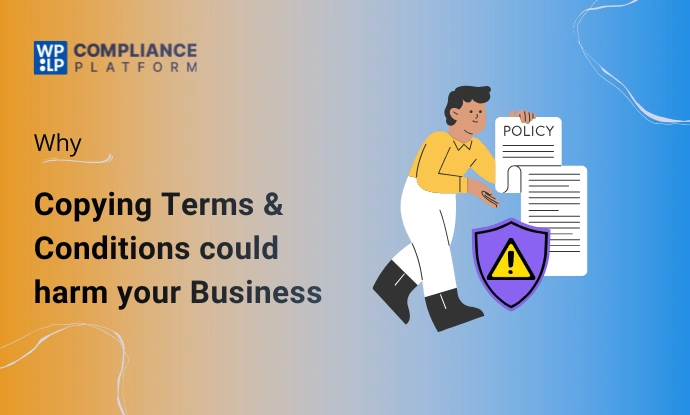
Summary
This blog points out the risks of copying T&Cs, the primary elements found in effective T&Cs, and how website owners can use WPLP Compliance Platform to create their own compliant, legal T&Cs easily and customize them as required. With WPLP, your website can remain professional, trusted and legally compliant/ protected.
Have you ever copied Terms and Conditions from another website just to save time? It’s very common, as many website owners and entrepreneurs do it, believing it’s a safe shortcut to fulfil a legal requirement for their website.
But do you know that copying Terms and Conditions (T&C) can put your business at serious risk?
Your Terms and Conditions define how your business and users interact. They outline what’s allowed, what isn’t, and how disputes are handled. Copying someone else’s T&C might look like a shortcut, but it often brings hidden problems – from non-compliance to legal penalties.
Each site has a different way of running, and it is directed to other jurisdictions and offers different terms. The T&C copy can include terms that do not suit your business or even be against the law of the T&C copyright.
Luckily, there are a variety of tools that will assist you in creating totally customised, legally compliant terms, even if you are not a lawyer.
This article will educate you about the dangers of copying Terms and Conditions, the best practices to follow when creating your own policies and ensure that the WPLP Compliance Platform can ensure that you are compliant.
What are Terms and Conditions?
Terms and Conditions (also called Terms of Service or Terms of Use) are the rules that define how people can use your website, products, or services.
They outline the ways in which people can browse and use your website and the services you can offer.
The standard T&C page commonly includes
- Responsibilities of users and illegal activities
- Policies of payment, refund, and cancellation
- Intellectual property ownership and usage rights
- Disclaimers and Limitations of Liability
- Governing law and dispute resolution procedures
When you have an online store, a SaaS, or any other digital service, it is necessary to have a professionally prepared Terms and Conditions page. It safeguards you against malpractices, makes user responsibilities easier to understand, and limits your liability during disagreements.
Today, many sites bundle their Terms and Conditions with privacy and cookie policies to show users that compliance and transparency matter.
In the absence of a Terms and Conditions page, you will not be able to control the actions of users, experience problems with compliance, and may also lose your reputation. It is not only a formality of the law but also the first line of defence of your site.
Why is T&C a Legal Necessity?
If you run an eCommerce business or offer SaaS, you need a strong T&C for several reasons:
- Setting the Rules: It provides a framework for user obligations, acceptable behaviour, and prohibited actions, preventing your website from misuse.
- Liability Limitation: In case of errors, disputes, or damages, your T&C includes clauses that can legally limit your business’s obligations, providing an extra layer of security.
- Intellectual Property Protection: It claims your ownership over your logos, content, software, and other elements of the website, limiting unauthorised use by others.
- Resolving Disputes: In case of any disputes, it indicates the process for resolving them. It often talks about requiring arbitration or setting the governing law and jurisdiction, which can save you massive costs in litigation.
- Grounds for Termination: It builds such conditions under which a user’s account can be eliminated (e.g. for violating usage or non-payment policies).
You can’t operate your digital business without clear and relevant T&C. It will leave you exposed to user disputes, intellectual property theft, and expensive lawsuits.
Can You Legally Copy T&C?
It is illegal to copy terms & conditions from another website.
Even though T&C pages look similar, they’re protected by copyright as original legal documents. Copying them is like copying someone else’s contract and yes, it can get you sued.
Why Copying T&C Is Dangerous for Your Business
- Copyright Violation: Duplicating the terms and conditions of a different site may result in legal action.
- Irrelevant Clauses: The clause of a competitor may not complement your services, hence confusing your customers.
- Terms not enforceable: Courts may not agree to duplicated or irrelevant terms when they are not related to your business.
- Loss of Credibility: A user can tell when the legal pages of the website have been duplicated, and this makes you look irresponsible and unprofessional.
- Compliance Failure: Copied T&C may not align with GDPR, CCPA, or LGPD standards.
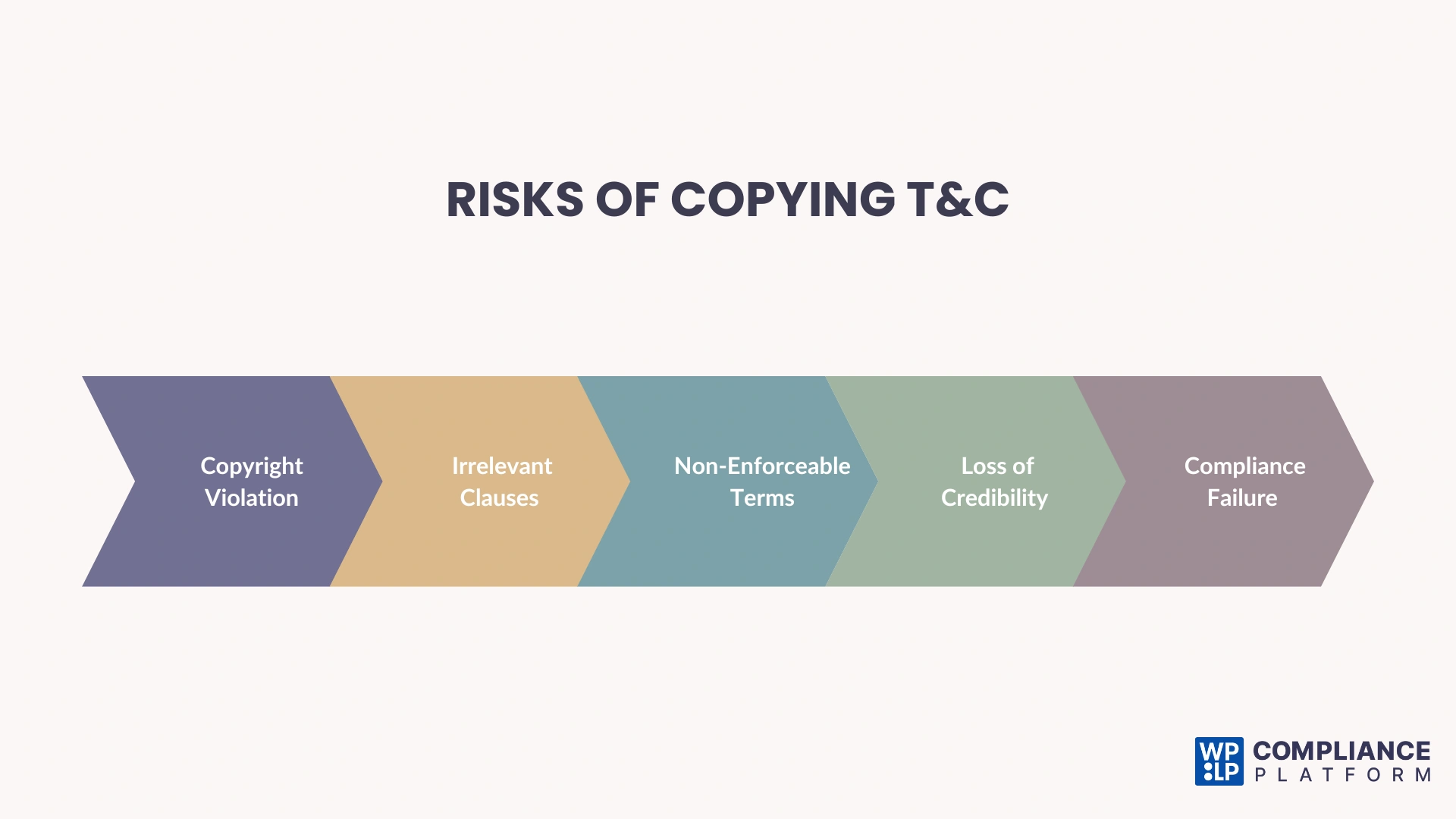
For example, imagine a small fashion store copying the Terms and Conditions of a tech company.
Their T&C might mention APIs or developer licenses – irrelevant and confusing to shoppers. And in a refund dispute, those copied clauses wouldn’t protect the store at all.
In a case of a refund dispute, the fashion store will not be safeguarded by the policy since it was not developed to be applied in such a business.
That’s why creating your own Terms and Conditions is the smarter and safer move. Tools like WPLP Compliance Platform make this process quick, accurate, and fully compliant.
Best Practices for Creating T&C
Creating T&C for your website or business does not have to be overwhelming. Let’s discuss a few best practices to ensure your document is both compliant and practical:
1. Use a Trusted Generator or Template
Start with a reliable tool. The WPLP Compliance Platform offers legally reviewed templates tailored for WordPress, eCommerce, and SaaS sites.
2. Include Key Legal Elements
Your T&C must cover these legal clauses:
- Use conduct and prohibited activities
- Payment, refund, and delivery terms
- Intellectual property protection
- Disclaimer of warranties and limitation of liability
- Governing law and jurisdiction
3. Customise for your Business
Generic terms rarely fit every business. Personalize your T&C to reflect your policies, pricing, and user responsibilities.
4. Keep it Updated
Regulations evolve. Review your T&C periodically, especially when privacy laws (like GDPR or CCPA) change.
5. Ensure Visibility
Put your Terms and Conditions where they are visible to visitors. The familiar places are to feature it at the bottom of the website, the main menu, or the sign-in and sign-up pages, or the checkout page, thus ensuring enforceability.
It is a legal safeguard as well as fosters trust and transparency with the audience because a considerate and tailored approach can actually be protective.
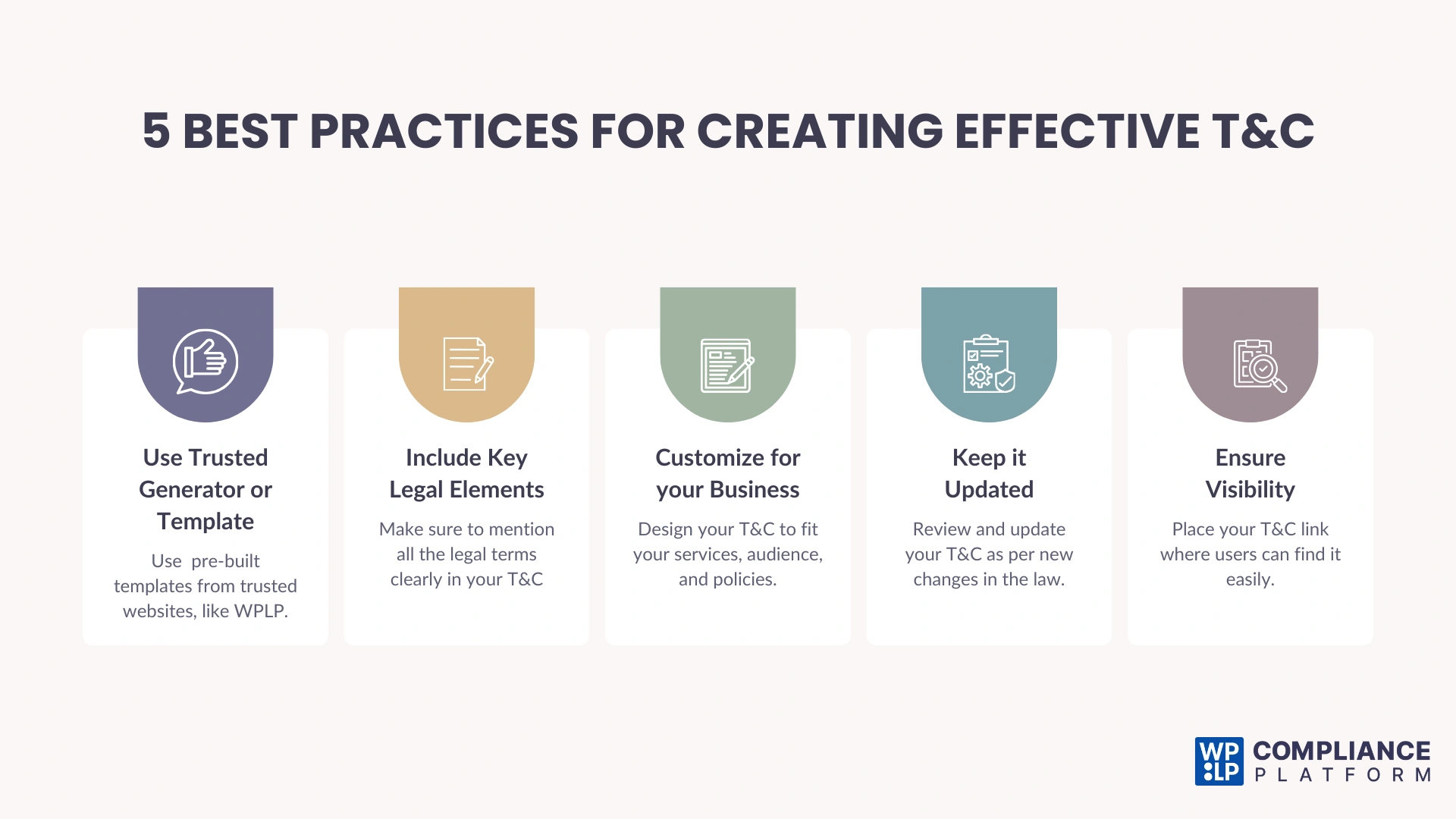
How WPLP Compliance Platform Helps
The WPLP Compliance Platform helps WordPress website owners generate legally compliant Terms and Conditions, Privacy Policies, and Cookie Policies – all from one dashboard.
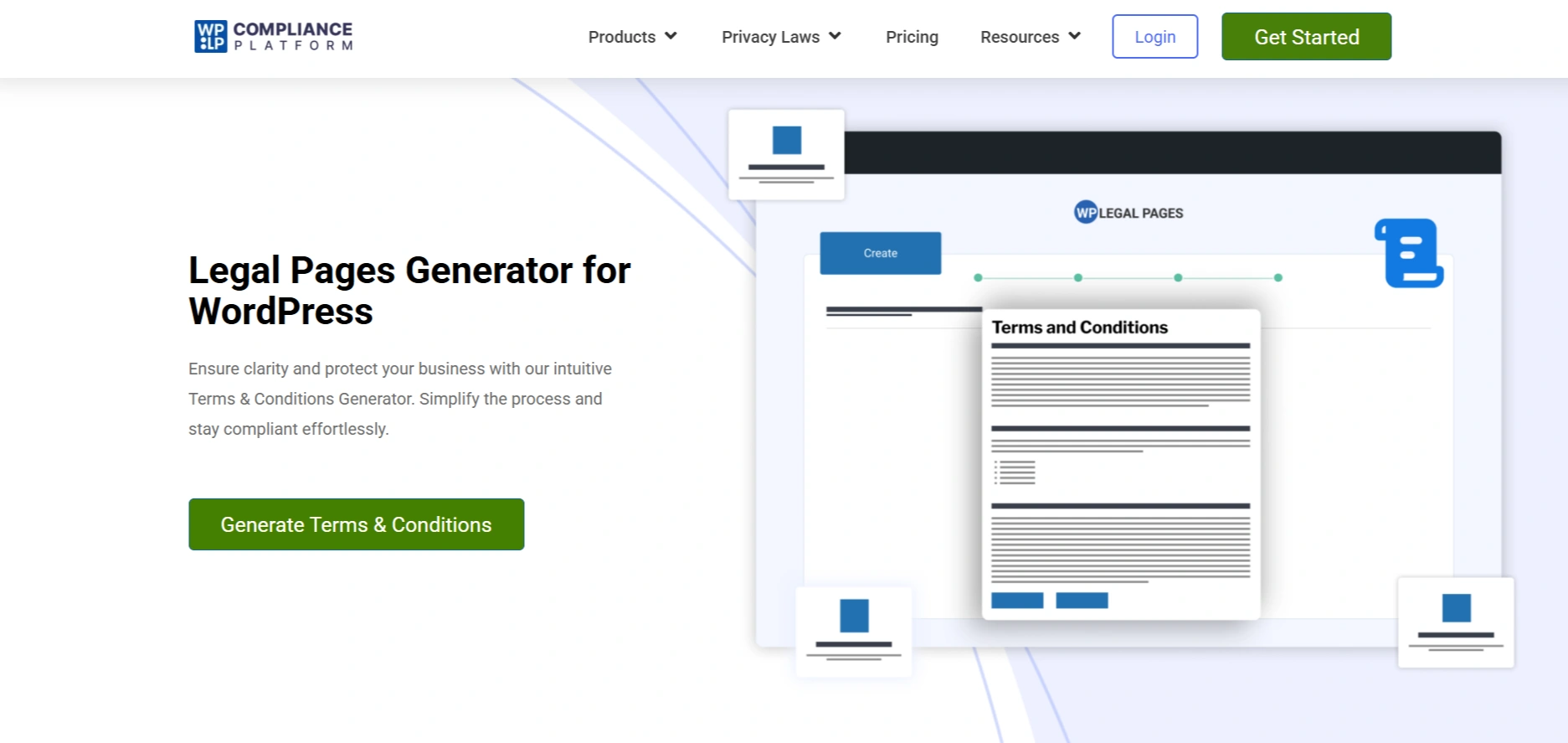
WP Legal Pages is a reliable WordPress plugin that assists you in creating pages that are legally compliant on your website.
It provides templates that you can use right away to ensure your site meets global privacy and data protection laws.
If you have a website, WP Legal Pages takes the hassle out of creating all of the important legal documents, like T&C, and Privacy Policies that help you keep your website transparent, credible, and compliant, without the legal headache.
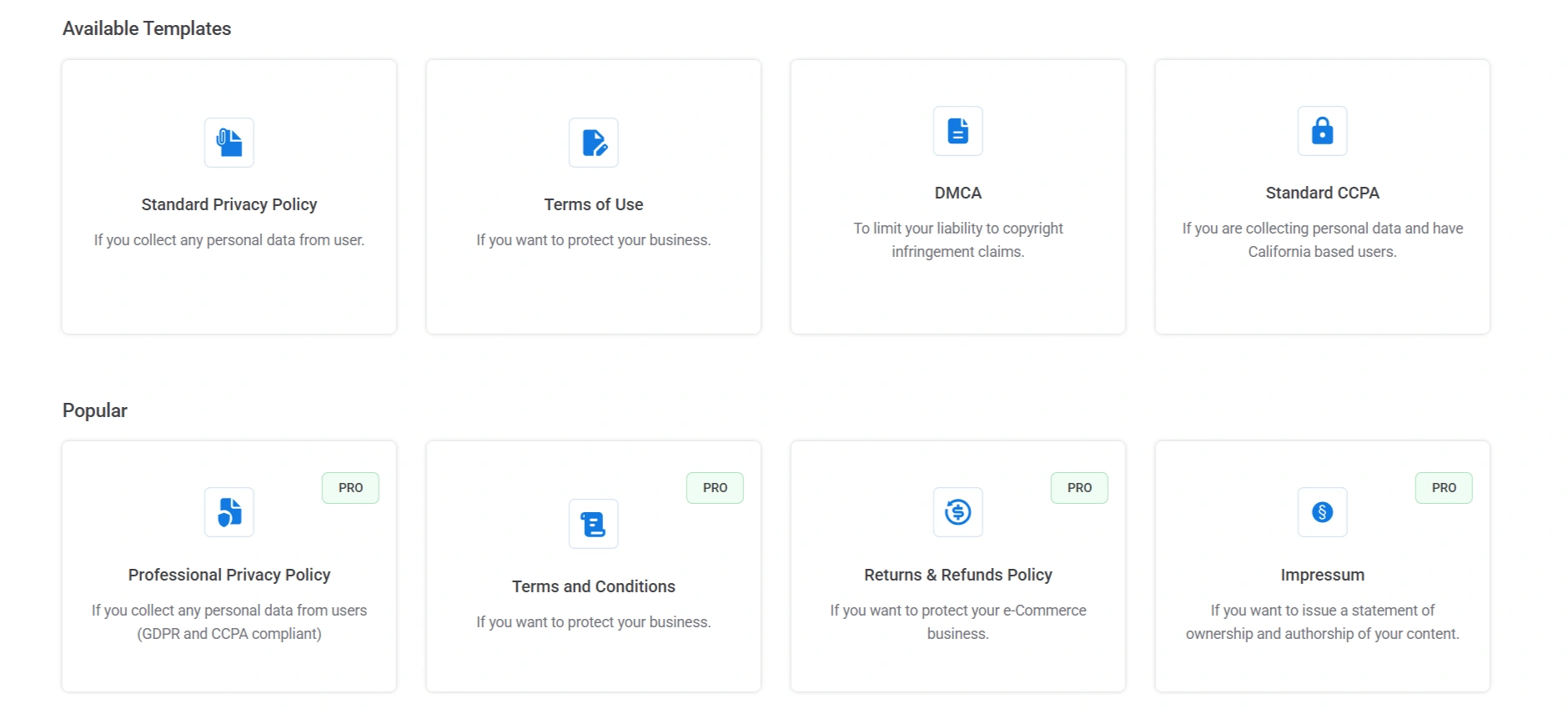
You don’t need legal expertise. WPLP’s templates are built by legal experts, customizable for your business type, and automatically updated as privacy laws evolve.
Key Features
- Custom T&C Generator: Develop completely customised legal contracts based on the nature of your website, the region, and your audience.
- Pre-Built Templates: Make use of professionally reviewed templates specific to individual industries like eCommerce, SaaS, agencies, and blogs.
- Global Law Coverage: Access templates in compliance with key privacy regulations such as GDPR, CCPA and LGPD.
- Smart Auto-Updates: Your policies refresh automatically when laws change.
- WordPress Integration: Effortlessly generate, edit, and display your T&C, Privacy Policy, and Cookie Policy in your WordPress dashboard.
- Audit Logs: Keep track of every policy change for compliance verification.
The platform ensures that any business can have a professional and trustworthy online presence. WPLP automates privacy and T&C compliance instead of taking hours of research on the laws or hiring legal advisors to provide services, thus taking the burden off your shoulders and saving your time.
FAQ
No, it is not advised legally to copy Terms and Conditions from another website, as it is considered a copyright violation. WPLP Compliance Platform can help you in generating compliant and customized policies as per your business requirements.
It should include payment and refund policies, user responsibilities, disclaimers, property rights, and dispute resolution. The WPLP Compliance Platform comes with pre-built and legally reviewed templates that include all legitimate fundamentals tailored to your website type.
WPLP simplifies creating policy pages for your website, legal pages in WordPress and managing other legal pages in one place. It supports GDPR, CCPA, and other global privacy laws, ensuring your website stays compliant.
Free templates are usually generic and may not align with your business requirements. Always ensure your T&C are tailored and compliant, preferably generated via a custom Terms and Conditions generator.
You should consider updating your T&C at least once a year or whenever you make a change in your services, policies, or other privacy laws. WPLP automatically updates all your legal documents for you.
Conclusion
It might appear easy and quick to copy the terms and conditions of another site, but it can lead to copyright violation, invalid terms, and breach of terms and regulations, resulting in damage to the reputation of your business.
Each business is unique, and there exist goals and structures that should be reflected in your legal documents.
With the WPLP Compliance Platform, you can:
- Easily generate customised, compliant T&C pages
- Ensure uniformity with GDPR, CCPA, and other global privacy laws
- Single dashboard to regulate all the legal pages of your website
Copying Terms and Conditions is a clear sign of risking your business. Instead, customise original, compliant Terms and Conditions aligning to your business model, audience and other policies.
And in case you liked to read this article, then consider reading our other similar articles here:
- Do I need a Privacy Policy for my Website?
- Best Terms & Conditions Generators for Websites
- How to add Terms & Conditions Page in WordPress
Ready to customize Terms and Conditions for your website? Use WPLP Compliance Platform to create yours today!
Disclaimer: This article is for informational and educational purposes only and is not legal advice.
